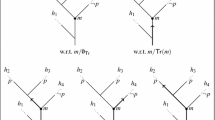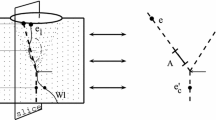Abstract
The basic notions in Prior’s Ockhamist and Peircean logics of branching-time are the notion of moment and that of history (or course of events). In the tree semantics, histories are defined as maximal linearly ordered sets of moments. In the geometrical approach, both moments and histories are primitive entities and there is no set theoretical (and ontological) dependency of the latter on the former. In the topological approach, moments can be defined as the elements of a rank 1 base of a non-Archimedean topology on the set of histories. In this paper, it will be shown that the topological approach, and hence the other approaches, can be reconstructed in a framework in which the basic notions are those of history and of relative closeness relation among histories.
Similar content being viewed by others
References
Belnap N., Perloff M., Xu M. (2001). Facing the Future. Agents and Choices in Our Indeterminst World, Oxford University Press.
van Benthem, J. (1995). ‘Temporal Logic’, in D. Gabbay, C. Hogger, and J. Robinson (eds.), Handbook of Logic in Artificial Intelligence and Logic Programming, Vol. 4. Oxford University Press, pp. 241–350.
van Benthem, J. (1996). ‘Content versus Wrapping: An Essay in Semantic Complexity’, in M. Marx, L. Pólos, and M. Masuch (eds.), Arrow Logic and Multi-Modal Logic, Studies in Logic, Language and Information. Stanford, CSLI Publications, pp. 203–219.
J. Burgess (1978) ArticleTitle‘The Unreal Future’ Theoria 44 157–179 Occurrence Handle10.1111/j.1755-2567.1978.tb00175.x
J. Burgess (1979) ArticleTitle‘Logic and Time’ Journal of Symbolic Logic 44 556–582
J. Burgess (1980) ArticleTitle‘Decidability for Branching Time’ Studia Logica 39 203–218 Occurrence Handle10.1007/BF00370320
P.J. Nyikos (1999) ArticleTitle‘On Some non-Archimedean Spaces of Alexandroff and Urysohn’ Topology and its Applications 91 1–23 Occurrence Handle10.1016/S0166-8641(97)00239-3
Øhrstrøm, P. and P. F. V. Hasle (1995). Temporal Logic: From Ancient Ideas to Artificial Intelligence, Studies in Linguistic and Philosophy. Dordrecht, Reidel.
Prior, A. (1967). Past, Present and Future. Oxford, Clarendon.
M. Sabbadin A Zanardo (2003) ArticleTitle‘Topological Aspects of Branching-time Semantics’ Studia Logica 75 271–286 Occurrence Handle10.1023/B:STUD.0000009560.90259.de
A. Zanardo (1985) ArticleTitle‘A Finite Axiomatization of the Set of Strongly Valid Ockhamist Formulas’ Journal of Philosophical Logic 14 447–468 Occurrence Handle10.1007/BF00649485
A. Zanardo (1996) ArticleTitle‘Branching-time logic with quantification Over Branches: The Point of View of Modal Logic’ Journal of Symbolic Logic 61 IssueID1 1–39 Occurrence Handle10.2307/2275595
Zanardo, A. (2003). ‘First-Order and Second-Order Aspects of Branching-Time Semantics’. Preprint Dipartimento di Matematica Università di Padova, N. 03, 17 febbraio 2003. Presented at HPLMC-02, Second International Workshop oh the History and Philosophy of Logic, Mathematics and Computation (Donostia-San Sebastian, Spain, 7–9 November, 2002).
Author information
Authors and Affiliations
Corresponding author
Rights and permissions
About this article
Cite this article
Zanardo, A. Moment/History Duality in Prior’s Logics of Branching-Time. Synthese 150, 483–507 (2006). https://doi.org/10.1007/s11229-005-5519-4
Issue Date:
DOI: https://doi.org/10.1007/s11229-005-5519-4




